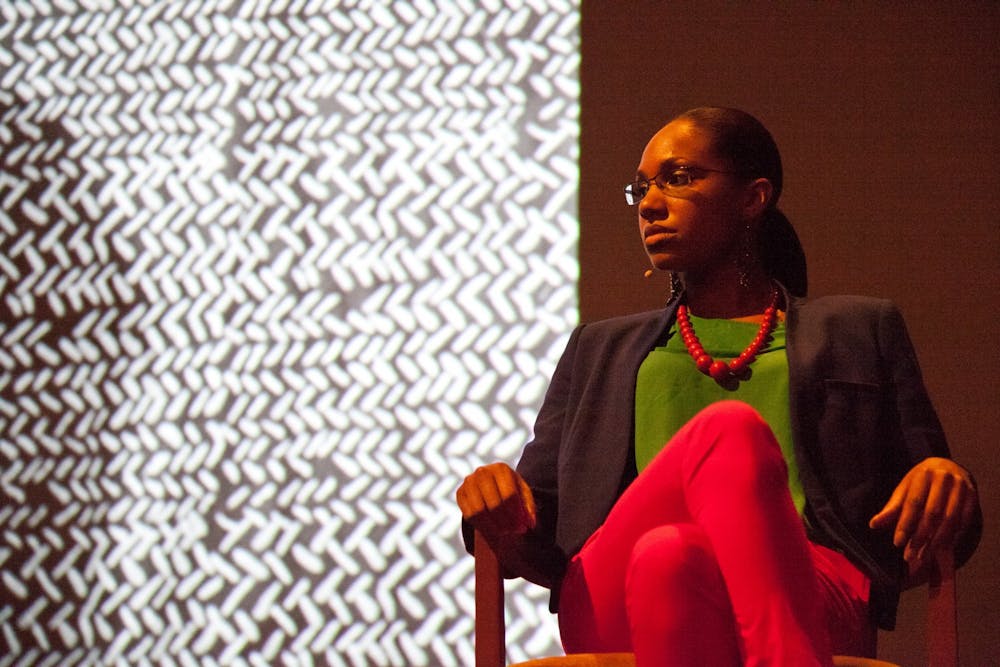The University’s Department of Art hosted “Art as Transformation: Using Photography for Social Change,” a talk with photographer LaToya Ruby Frazier, on Oct. 27. Frazier’s award-winning photo-history book “The Notion of Family” explores the impacts of racism and economic decline in America’s small towns, as embodied in Frazier’s hometown of Braddock, Pa. From Pennsylvania to Flint, Mich. to the Borinage in Belgium, Frazier’s photography confronts social and political legacies plaguing marginalized groups and reclaims a distinct and thoughtful space for those voices to be recognized and celebrated.
Provoked by her work in “The Notion of Family,” Frazier was invited to the coal mining region of the Borinage in Belgium to document the lives and stories of coal miners and their families in the town. Frazier emphasized the importance of being invited into the community.
"I don't go anywhere without being invited,” Frazier said.
As an artist, she takes part in a lifelong commitment to her documentary work, seeing her art as bodies of work that lead to her next body of work, instead of viewing her work as segmented, individual projects.
As a guest of the town, Frazier spent hours getting to know community members, noting in particular her interactions with three male coal miners that she photographed in a statuesque manner juxtaposed to the trees in the background. She explained how her work layers together portraits, still lifes and landscapes to create one narrative about the community and its inhabitant’s lives.
“Documentation and being present with people and honoring that and making it very large, there’s a lot of power in that,” Frazier said. “Their memories become an imprint in their own mind, these are living works of art.”
Frazier described artists as standing in the gap between the working class and the creative class, underscoring the importance of understanding an artist’s role in both institutions and communities. She noted an artist’s responsibility to expose the nation’s failures and shortcomings through art, explaining “we should be a part of those that love them so much we are willing to tell the truth.” To reckon with the intense relationship between the artist and society, Frazier urged audiences to use James Baldwin's “The Creative Process” as their personal manifesto to consider the appropriate role of an artist to critique society and facilitate change. Baldwin sees artists and society as lovers, with the mission to reveal the society’s true nature and make freedom real.
Since the coal miners shared their grievances with Frazier that the town and local museum rarely honored their contributions, Frazier chose to symbolically hand their history back to those whose labor shaped the region. The exhibition opened for the coal miners and their families first for a three-hour walkthrough, with tours led by the coal miners in their uniforms from decades past. By changing the hierarchy of the opening, Frazier’s art acted as a work of transformation, giving the power of the legacy of the region back to the coal miners by creating art for and about the people.
Frazier described this action as the necessary democratization of art, elaborating that working class people must see themselves reflected in art.
“I am intentionally making an archive that shows how because working class people are because this country needs it,” Frazier said. “I want justice for working people.”
Instead of working outside of the system, Frazier said she utilizes corporations to subvert the status quo, noting the significance of her work showcasing two female auto workers being featured on the cover of The New York Times Magazine Money Issue.
Frazier’s next project collides with the current political atmosphere, namely President Donald Trump’s encouragement of using hydroxychloroquine to battle the COVID-19 pandemic. As an immunocompromised Black woman with Lupus — which is treated through the prescription of hydroxychloroquine — Frazier explored her struggle to obtain this medicine through her insurance company during the pandemic. Through her work, Frazier hopes to raise awareness that Black women, Asian women and transgender women are disproportionately affected by this autoimmune disease — for which their life-saving treatment has been increasigly difficult to obtain.
At the end of the conversation, Frazier underlined the need for a rise of new artists to convey what mass media fails to represent. Noting how the mass media is controlled by a total of six conglomerates, Frazier urged young artists to be cautious in consuming mass media, encouraging them to work outside of the system to breathe fresh life and create newer stories.
For more information about LaToya Ruby Frazier and her photography, visit her website.







